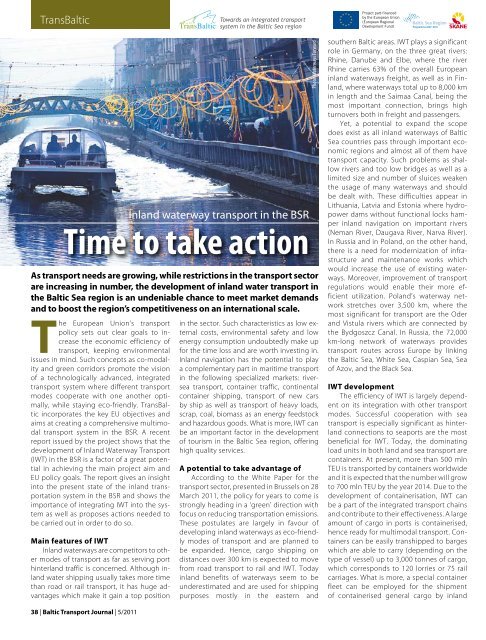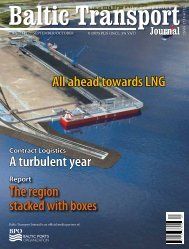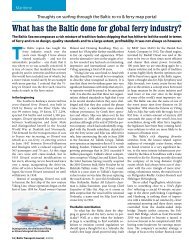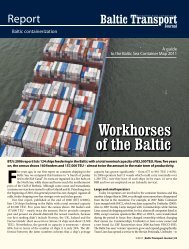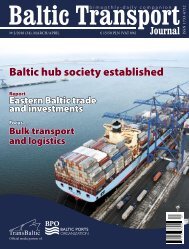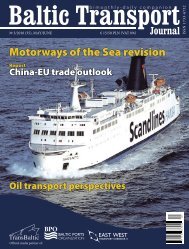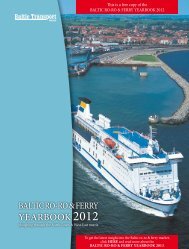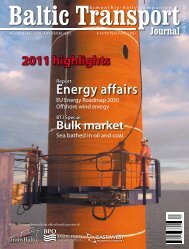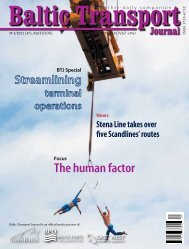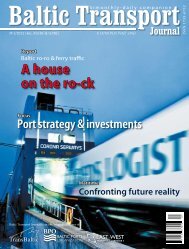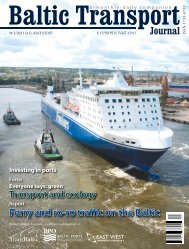BTJ 5/2011 - Baltic Press
BTJ 5/2011 - Baltic Press
BTJ 5/2011 - Baltic Press
- No tags were found...
You also want an ePaper? Increase the reach of your titles
YUMPU automatically turns print PDFs into web optimized ePapers that Google loves.
Trans<strong>Baltic</strong>Towards an integrated transportsystem in the <strong>Baltic</strong> Sea regionProject part-financedProject part-financedby the European Unionby the European Union (European Regional Development Fund)(European Regional Development Fund)Inland waterway transport in the BSRTime to take actionAs transport needs are growing, while restrictions in the transport sectorare increasing in number, the development of inland water transport inthe <strong>Baltic</strong> Sea region is an undeniable chance to meet market demandsand to boost the region’s competitiveness on an international scale.The European Union’s transportpolicy sets out clear goals to increasethe economic efficiency oftransport, keeping environmentalissues in mind. Such concepts as co-modalityand green corridors promote the visionof a technologically advanced, integratedtransport system where different transportmodes cooperate with one another optimally,while staying eco-friendly. Trans<strong>Baltic</strong>incorporates the key EU objectives andaims at creating a comprehensive multimodaltransport system in the BSR. A recentreport issued by the project shows that thedevelopment of Inland Waterway Transport(IWT) in the BSR is a factor of a great potentialin achieving the main project aim andEU policy goals. The report gives an insightinto the present state of the inland transportationsystem in the BSR and shows theimportance of integrating IWT into the systemas well as proposes actions needed tobe carried out in order to do so.Main features of IWTInland waterways are competitors to othermodes of transport as far as serving porthinterland traffic is concerned. Although inlandwater shipping usually takes more timethan road or rail transport, it has huge advantageswhich make it gain a top positionPhoto: Waterways Forwardin the sector. Such characteristics as low externalcosts, environmental safety and lowenergy consumption undoubtedly make upfor the time loss and are worth investing in.Inland navigation has the potential to playa complementary part in maritime transportin the following specialized markets: riverseatransport, container traffic, continentalcontainer shipping, transport of new carsby ship as well as transport of heavy loads,scrap, coal, biomass as an energy feedstockand hazardous goods. What is more, IWT canbe an important factor in the developmentof tourism in the <strong>Baltic</strong> Sea region, offeringhigh quality services.A potential to take advantage ofAccording to the White Paper for thetransport sector, presented in Brussels on 28March <strong>2011</strong>, the policy for years to come isstrongly heading in a ‘green’ direction withfocus on reducing transportation emissions.These postulates are largely in favour ofdeveloping inland waterways as eco-friendlymodes of transport and are planned tobe expanded. Hence, cargo shipping ondistances over 300 km is expected to movefrom road transport to rail and IWT. Todayinland benefits of waterways seem to beunderestimated and are used for shippingpurposes mostly in the eastern andsouthern <strong>Baltic</strong> areas. IWT plays a significantrole in Germany, on the three great rivers:Rhine, Danube and Elbe, where the riverRhine carries 63% of the overall Europeaninland waterways freight, as well as in Finland,where waterways total up to 8,000 kmin length and the Saimaa Canal, being themost important connection, brings highturnovers both in freight and passengers.Yet, a potential to expand the scopedoes exist as all inland waterways of <strong>Baltic</strong>Sea countries pass through important economicregions and almost all of them havetransport capacity. Such problems as shallowrivers and too low bridges as well as alimited size and number of sluices weakenthe usage of many waterways and shouldbe dealt with. These difficulties appear inLithuania, Latvia and Estonia where hydropowerdams without functional locks hamperinland navigation on important rivers(Neman River, Daugava River, Narva River).In Russia and in Poland, on the other hand,there is a need for modernization of infrastructureand maintenance works whichwould increase the use of existing waterways.Moreover, improvement of transportregulations would enable their more efficientutilization. Poland’s waterway networkstretches over 3,500 km, where themost significant for transport are the Oderand Vistula rivers which are connected bythe Bydgoszcz Canal. In Russia, the 72,000km-long network of waterways providestransport routes across Europe by linkingthe <strong>Baltic</strong> Sea, White Sea, Caspian Sea, Seaof Azov, and the Black Sea.IWT developmentThe efficiency of IWT is largely dependenton its integration with other transportmodes. Successful cooperation with seatransport is especially significant as hinterlandconnections to seaports are the mostbeneficial for IWT. Today, the dominatingload units in both land and sea transport arecontainers. At present, more than 500 mlnTEU is transported by containers worldwideand it is expected that the number will growto 700 mln TEU by the year 2014. Due to thedevelopment of containerisation, IWT canbe a part of the integrated transport chainsand contribute to their effectiveness. A largeamount of cargo in ports is containerised,hence ready for multimodal transport. Containerscan be easily transhipped to bargeswhich are able to carry (depending on thetype of vessel) up to 3,000 tonnes of cargo,which corresponds to 120 lorries or 75 railcarriages. What is more, a special containerfleet can be employed for the shipmentof containerised general cargo by inland38 | <strong>Baltic</strong> Transport Journal | 5/<strong>2011</strong>


